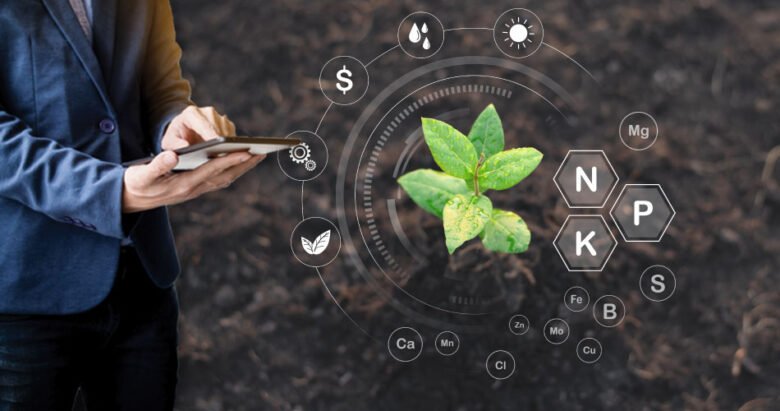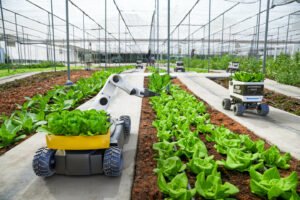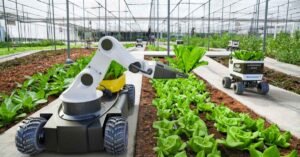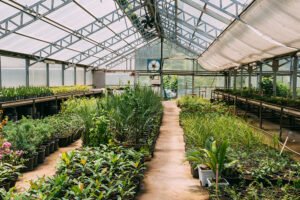Crop monitoring systems are changing the way farmers care for their crops and achieve optimal yields, making them an important tool in modern agriculture. These systems use advanced technology, data analytics, and sensors to provide real-time information about crop health, growth, and different parts of the environment. This detailed guide discusses the key components, advantages, and disadvantages of crop tracking systems.
1. Composition of Crop Monitoring System:
Collection of Data and Sensors
- Various types of sensors are used in crop monitoring systems, such as weather stations, sensors that measure soil moisture, and drones with multispectral cameras.
- Weather stations provide accurate information about temperature, humidity, wind speed, rain, and snow in real time to help people make correct decisions.
- Farmers can use soil moisture sensors to closely monitor soil moisture to plan optimal irrigation schedules.
- Multispectral cameras on drones take high-resolution photos that can be used to detect crop diseases, nutrient deficiencies, and other issues.
Images from Space
- Satellites allow us to see large agricultural areas from the sky, which tells us a lot about crop health and growth.
- Using remote sensing satellites, farmers can focus on crop conditions on a larger scale and make choices based on a wealth of information.
IoT and Internet
- The Internet of Things (IoT) is an important component of crop tracking systems as different devices and sensors can easily communicate with each other.
- Connected devices send information to central systems in real time, accelerating research and decision-making.
2. Why Crop Monitoring Systems are Useful:
Very Accurate Number of Hectares
- Precision farming is made possible by crop monitoring tools that allow farmers to change the way they farm certain parts of their fields.
- Precision gardening optimizes the use of water, fertilizers, and pesticides by reducing the amount of waste.
Catch Problems Early
- Farmers can detect problems such as diseases, pests, or nutritional deficiencies early by monitoring their crops.
- Early detection allows for quick action to stop the spread of disease and minimize crop losses.
Better Resource Management
- Crop monitoring tools provide farmers with information about soil health, helping them determine optimal watering times and keep an eye on nutrient levels.
- This leads to better use of resources and more environmentally friendly growing methods.
Make Decisions Based on Data
- Crop monitoring systems collect a wealth of information that farmers can use to make choices based on real-time data.
- Data analytics helps farmers discover patterns and trends so they can change plans for better results.
3. Challenges and Considerations:
Data Privacy and Security
- As people become increasingly reliant on technology, protecting private agricultural data is more important than ever.
- Farmers and technology companies must put data security first and take strong measures to keep information secure and prevent people from accessing it.
How Much Does It Cost to Implement
- Despite the many benefits of crop tracking systems, some farmers may not be able to afford the initial installation costs.
- To make these tools more accessible, governments and agricultural groups can help by providing subsidies or other forms of support.
Integrate with Existing Systems
- Integrating new technology with existing gardening methods and equipment can be difficult.
- To ensure a smooth transition and use of crop tracking systems, it is important to have a comprehensive training and support plan in place.
4. Future Trends in Crop Monitoring:
Self-learning Computers and AI
- By adding artificial intelligence and machine learning algorithms to crop tracking systems, they can make better predictions.
- These technologies can look at past data to guess at food yields, find the best way to use resources, and guess what problems might arise.
Using Blockchain in Agriculture
- Blockchain technology can help make agricultural supply chains more open and easier to track.
- By recording every immutable step in the crop production process, blockchain can ensure that customers and
Using Blockchain in Agriculture
- Blockchain technology can help make agricultural supply chains more open and easier to trace.
- By recording every immutable step in the crop production process, blockchain can ensure that customers and other stakeholders trust the system.
5. Sustainable Agriculture and its Impact on the Environment:
Ensure Source Protection
- Crop monitoring tools help make agriculture more sustainable by encouraging people to use resources wisely.
- More efficient use of water, fertilizers, and pesticides not only reduces costs for farmers but also reduces environmental damage caused by agricultural runoff.
Get Ready for Climate Change
- As the climate changes, crop monitoring methods become important to improve farmers’ resilience to the impacts of climate change.
- Real-time weather data and predictive analytics allow farmers to adapt to changing weather trends and ensure their crops grow well in unpredictable climates.
Keep Biodiversity Alive
- When biodiversity mapping tools are added to a crop monitoring system, they help protect and improve biodiversity on the farm.
- Farmers can maintain a balance between growing crops and protecting natural areas by making informed decisions. This makes the ecosystem more stable.
6. Impact on the Community and the World:
Food Safety
- Improving agricultural productivity through the widespread use of crop monitoring equipment can help ensure food security around the world.
- These systems help meet the growing food needs of a more populous world by ensuring that crops produce the most food and lose the least.
Rural Growth
- The use of new tools in agriculture, such as crop monitoring systems, can help rural areas develop and improve.
- More productive and efficient farmers can help grow the rural economy by creating jobs and improving lives in agricultural regions.
Conclusion
Today, crop tracking systems are an important part of modern agriculture and help farmers around the world in many ways. As technology continues to develop, these methods will become even more important to ensure that agriculture is sustainable and efficient. The agricultural sector can make the most of crop monitoring systems by tackling problems, introducing new tools, and encouraging people to work together to achieve a more productive and resilient future.
FAQs
1. What are the crop monitoring methods?
Crop monitoring systems are integrated agricultural technologies that use sensors, data analytics, and other advanced technologies to monitor and control various parts of crop health, growth, and environment. It provides farmers with real-time information to help them make informed choices and improve agricultural practices.
2. What are the components of a crop monitoring method?
Sensors (such as weather stations, soil moisture sensors, and drones), satellite imagery, Internet of Things (IoT) devices, connectivity solutions, and data analysis tools are some of the different components that make up a crop tracking system. All these components work together to collect and analyze the data needed for good crop management.
3. What role do monitors play in monitoring crops?
Sensors are important for crop monitoring because they collect real-time information about weather, groundwater levels, and crop health. This information is then used to make informed choices about watering, fertilizing, and eradicating pests to increase food production.
4. What can farmers do about the high costs of installing instruments to monitor their crops?
Governments, agricultural groups, and technology companies can work together to make these tools more accessible to farmers by offering financial incentives, subsidies, or support programs.
5. What role do artificial intelligence and machine learning play in crop monitoring?
Artificial intelligence and machine learning make it easier for crop monitoring tools to make predictions. These technologies look at past data to guess crop yields, find the best way to use resources, and guess what problems might arise.



